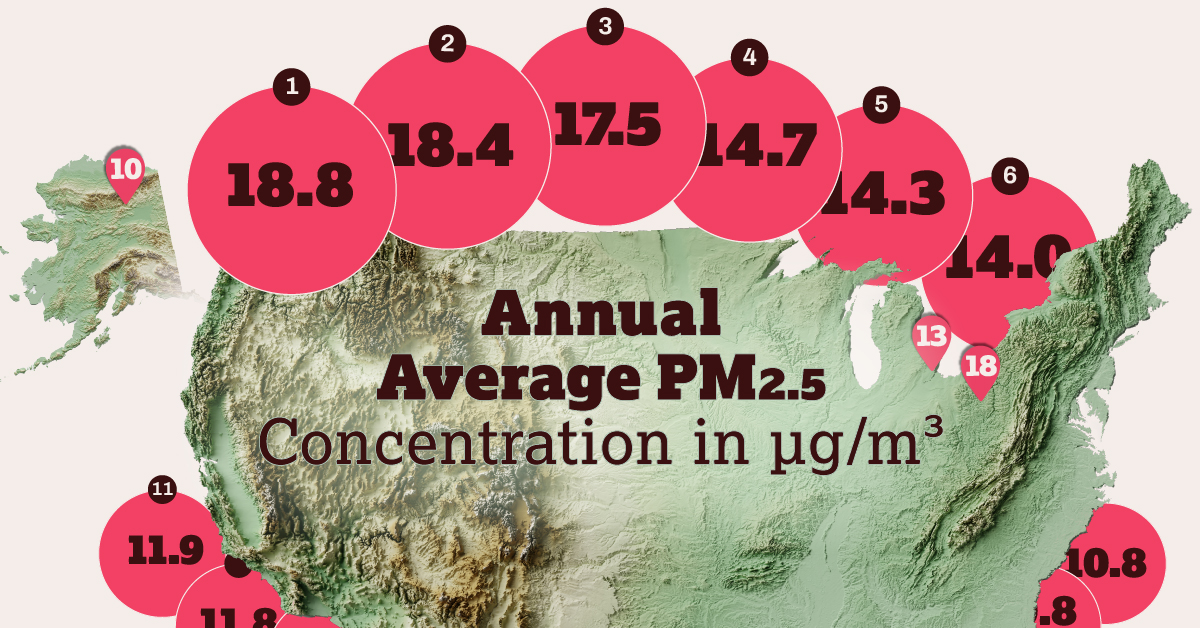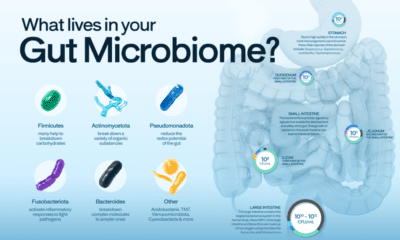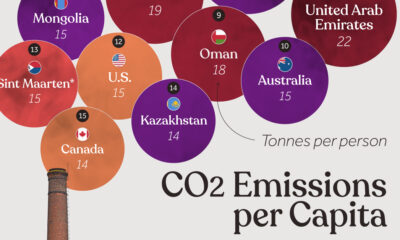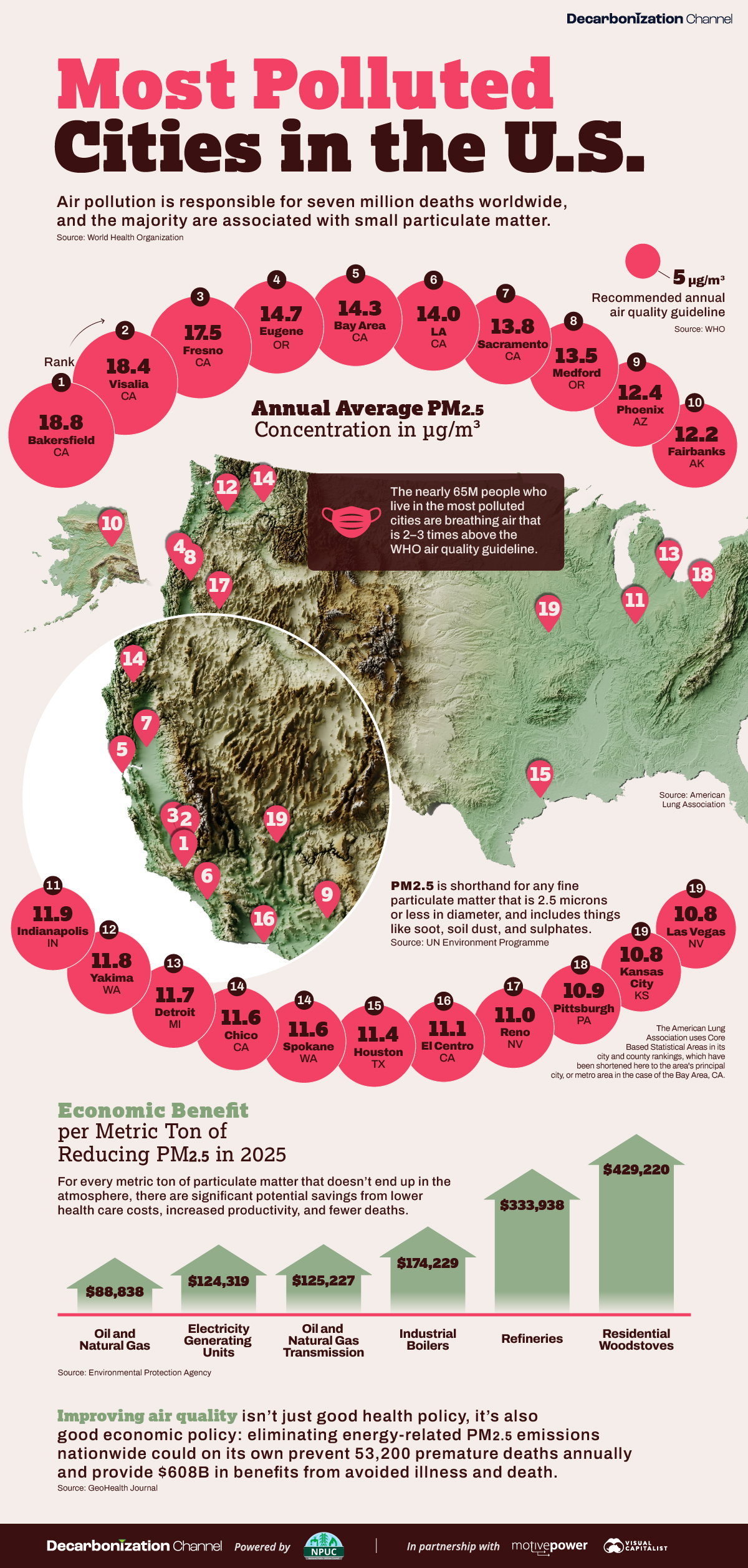Green
The Carbon Footprint of Major Travel Methods
![]() See this visualization first on the Voronoi app.
See this visualization first on the Voronoi app.
The Carbon Footprint of Major Travel Methods
This was originally posted on our Voronoi app. Download the app for free on iOS or Android and discover incredible data-driven charts from a variety of trusted sources.
Did you know that transport accounts for nearly one-quarter of global energy-related carbon dioxide (CO₂) emissions?
This graphic illustrates the carbon footprints of major travel methods measured in grams of carbon dioxide equivalent (CO₂e) emitted per person to travel one kilometer. This includes both CO₂ and other greenhouse gases.
Data is sourced from Our World in Data, the UK Government’s Department for Energy Security and Net Zero, and The International Council on Clean Transportation, as of December 2022.
These figures should be interpreted as approximations, rather than exact numbers. There are many variables at play that determine the actual carbon footprint in any individual case, including vehicle type or model, occupancy, energy mix, and even weather.
Cruise Ships are the Most Carbon-Intensive Travel Method
According to these estimates, taking a cruise ship, flying domestically, and driving alone are some of the most carbon-intensive travel methods.
Cruise ships typically use heavy fuel oil, which is high in carbon content. The average cruise ship weighs between 70,000 to 180,000 metric tons, meaning they require large engines to get moving.
These massive vessels must also generate power for onboard amenities such as lighting, air conditioning, and entertainment systems.
Short-haul flights are also considered carbon-intensive due to the significant amount of fuel consumed during initial takeoff and climbing altitude, relative to a lower amount of cruising.
| Transportation method | CO₂ equivalent emissions per passenger km |
|---|---|
| Cruise Ship | 250 |
| Short-haul flight (i.e. within a U.S. state or European country) | 246 |
| Diesel car | 171 |
| Gas car | 170 |
| Medium-haul flight (i.e. international travel within Europe, or between U.S. states) | 151 |
| Long-haul flight (over 3,700 km, about the distance from LA to NY) | 147 |
| Motorbike | 113 |
| Bus (average) | 96 |
| Plug-in hybrid | 68 |
| Electric car | 47 |
| National rail | 35 |
| Tram | 28 |
| London Underground | 27 |
| Ferry (foot passenger) | 19 |
| Eurostar (International rail) | 4.5 |
Are EVs Greener?
Many experts agree that EVs produce a lower carbon footprint over time versus traditional internal combustion engine (ICE) vehicles.
However, the batteries in electric vehicles charge on the power that comes straight off the electrical grid—which in many places may be powered by fossil fuels. For that reason, the carbon footprint of an EV will depend largely on the blend of electricity sources used for charging.
There are also questions about how energy-intensive it is to build EVs compared to a comparable ICE vehicle.
Environment
The Most Polluted Cities in the U.S.
What are the most polluted cities in the U.S. according to data from the American Lung Association’s 2024 State of the Air Report?

The Most Polluted U.S. Cities in 2024
According to the World Health Organization, air pollution is responsible for 7 million deaths annually, and could cost the global economy between $18–25 trillion by 2060 in annual welfare costs, or roughly 4–6% of world GDP.
And with predictions that 7 in 10 people will make their homes in urban centers by mid-century, cities are fast becoming one of the frontlines in the global effort to clear the air.
In this visualization, we use 2024 data from the State of the Air report from the American Lung Association to show the most polluted cities in the United States.
What is Air Pollution?
Air pollution is a complex mixture of gases, particles, and liquid droplets and can have a variety of sources, including wildfires and cookstoves in rural areas, and road dust and diesel exhaust in cities.
There are a few kinds of air pollution that are especially bad for human health, including ozone and carbon monoxide, but here we’re concerned with fine particulate matter that is smaller than 2.5 microns, or PM2.5 for short.
The reason for the focus is because at that small size, particulate matter can penetrate the bloodstream and cause all manner of havoc, including cardiovascular disease, lung cancer, and chronic pulmonary disease.
The American Lung Association has set an annual average guideline of 9 µg/m³ for PM2.5, however, the World Health Organization has set a much more stringent limit of 5 µg/m³.
The 21 Worst Polluted Cities in the U.S.
Here are the top 21 most polluted cities in the U.S., according to their annual average PM2.5 concentrations:
| Rank | City, State | Annual average concentration, 2020-2022 (µg/m3) |
|---|---|---|
| 1 | Bakersfield, CA | 18.8 |
| 2 | Visalia, CA | 18.4 |
| 3 | Fresno, CA | 17.5 |
| 4 | Eugene, OR | 14.7 |
| 5 | Bay Area, CA | 14.3 |
| 6 | Los Angeles, CA | 14.0 |
| 7 | Sacramento, CA | 13.8 |
| 8 | Medford, OR | 13.5 |
| 9 | Phoenix, AZ | 12.4 |
| 10 | Fairbanks, AK | 12.2 |
| 11 | Indianapolis, IN | 11.9 |
| 12 | Yakima, WA | 11.8 |
| 13 | Detroit, MI | 11.7 |
| T14 | Chico, CA | 11.6 |
| T14 | Spokane, WA | 11.6 |
| 15 | Houston, TX | 11.4 |
| 16 | El Centro, CA | 11.1 |
| 17 | Reno, NV | 11.0 |
| 18 | Pittsburgh, PA | 10.9 |
| T19 | Kansas City, KS | 10.8 |
| T19 | Las Vegas, NV | 10.8 |
Note: The American Lung Association uses Core Based Statistical Areas in its city and county rankings, which have been shortened here to the area’s principal city, or metro area in the case of the Bay Area, CA.
Six of the top seven cities are in California, and four in the state’s Central Valley, a 450-mile flat valley that runs parallel to the Pacific coast, and bordered by the Coast and Sierra Nevada mountain ranges. As a result, when pollution from the big population centers on the coast is carried inland by the wind—cities #5 and #6 on the list—it tends to get trapped in the valley.
Bakersfield (#1), Visalia (#2), and Fresno (#3) are located at the drier and hotter southern end of the valley, which is worse for air quality. The top three local sources of PM2.5 emissions in 2023 were farms (20%), forest management / agricultural waste burning (20%), and road dust (14%).
Benefit to Economy
While the health impacts are generally well understood, less well known are the economic impacts.
Low air quality negatively affects worker productivity, increases absenteeism, and adds both direct and indirect health care costs. But the flip side of that equation is that improving air quality has measurable impacts to the wider economy. The EPA published a study that calculated the economic benefits of each metric ton of particulate matter that didn’t end up in the atmosphere, broken down by sector.
| Sector | Benefits per metric ton |
|---|---|
| Residential Woodstoves | $429,220 |
| Refineries | $333,938 |
| Industrial Boilers | $174,229 |
| Oil and Natural Gas Transmission | $125,227 |
| Electricity Generating Units | $124,319 |
| Oil and Natural Gas | $88,838 |
At the same time, the EPA recently updated a cost-benefit analysis of the Clean Air Act, the main piece of federal legislation governing air quality, and found that between 1990 and 2020 it cost the economy roughly $65 billion, but also provided $2 trillion in benefits.
Benefit to Business
But that’s at the macroeconomic level, so what about for individual businesses?
For one, employees like to breathe clean air and will choose to work somewhere else, given a choice. A 2022 Deloitte case study revealed that nearly 70% of highly-skilled workers said air quality was a significant factor in choosing which city to live and work in.
At the same time, air quality can impact employer-sponsored health care premiums, by reducing the overall health of the risk pool. And since insurance premiums averaged $7,590 per year in 2022 for a single employee, and rose to $21,931 for a family, that can add up fast.
Consumers are also putting their purchase decisions through a green lens, while ESG, triple-bottom-line, and impact investing are putting the environment front and center for many investors.
And if the carrot isn’t enough for some businesses, there is the stick. The EPA recently gave vehicle engine manufacturer Cummins nearly two billion reasons to help improve air quality, in a settlement the agency is calling “the largest civil penalty in the history of the Clean Air Act and the second largest environmental penalty ever.”

Learn how the National Public Utilities Council is working toward the future of sustainable electricity.

-

 Environment1 month ago
Environment1 month agoRanked: Top Countries by Total Forest Loss Since 2001
The country with the most forest loss since 2001 lost as much forest cover as the next four countries combined.
-

 Environment3 months ago
Environment3 months agoCharted: Share of World Forests by Country
We visualize which countries have the biggest share of world forests by area—and while country size plays a factor, so too, does the environment.
-

 Environment4 months ago
Environment4 months agoWhich Countries Have the Largest Forests?
Together, the top five countries with the largest forests account for more than half of the world’s entire forest cover.
-

 Environment5 months ago
Environment5 months agoVisualized: What Lives in Your Gut Microbiome?
The human gut microbiome contains a world of microbes. We look at the the bacteria that deeply affect our health and well-being.
-

 Environment5 months ago
Environment5 months agoMapped: Global Temperature Rise by Country (2022-2100P)
In this set of three maps, we show the global temperature rise on a national level for 2022, 2050, and 2100 based on an analysis by…
-

 Environment5 months ago
Environment5 months agoRanked: Per Capita Carbon Emissions by Country
Which countries rank the highest in per capita carbon emissions, and how do they impact the world’s total carbon emissions?
-

 United States5 days ago
United States5 days agoMapped: Countries Where Recreational Cannabis is Legal
-

 Healthcare2 weeks ago
Healthcare2 weeks agoLife Expectancy by Region (1950-2050F)
-

 Markets2 weeks ago
Markets2 weeks agoThe Growth of a $1,000 Equity Investment, by Stock Market
-

 Markets2 weeks ago
Markets2 weeks agoMapped: Europe’s GDP Per Capita, by Country
-

 Money1 week ago
Money1 week agoCharted: What Frustrates Americans About the Tax System
-

 Technology1 week ago
Technology1 week agoCountries With the Highest Rates of Crypto Ownership
-

 Mining1 week ago
Mining1 week agoWhere the World’s Aluminum is Smelted, by Country
-

 Personal Finance1 week ago
Personal Finance1 week agoVisualizing the Tax Burden of Every U.S. State















